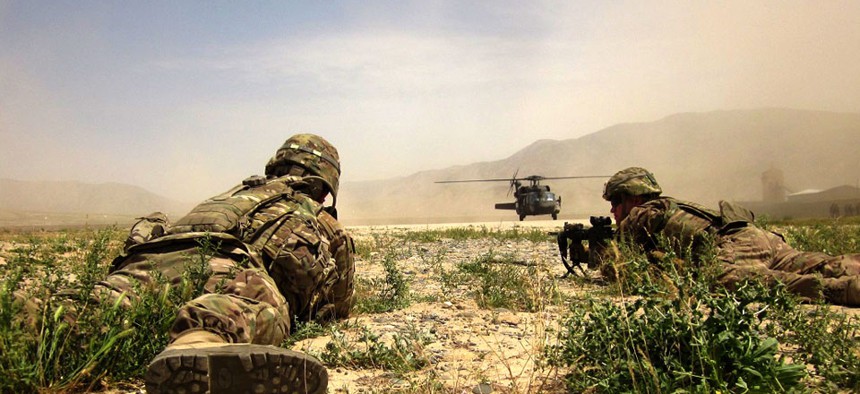
United States Army file photo
A Tale of Two Budget Wish Lists
The Pentagon and Congress will have to compete over limited cash.
Nobody in Washington is happy with the defense budget cuts coming next year. But the Pentagon and members of Congress each have their own ideas about how to spend any extra cash.
The Pentagon is hoping to minimize the full impact of the budget cuts with some extra financial padding. It has requested a budget of $496 billion for next year—which meets the budget caps Congress imposed—but the Pentagon has also submitted a hefty wish list of programs it wants if Congress can find an extra $26 billion.
However, not all of lawmakers’ pet projects are in the Pentagon’s base budget or even its wish list. Members of Congress are decrying the Pentagon’s proposed cuts to defense programs that could cause them political pain in their districts—and they desperately want to get them funded.
National Journal has outlined some of the key priorities the Pentagon and Congress have in their dueling wish lists—and what they would cost.
Of course, this extra cash is fictional, at least for now. There’s no room in the budget, and Congress may not change the law to give the Pentagon more money to spend. If members insist the Pentagon must fund their priorities anyway, the Pentagon would have to instead slash other programs in the main budget it considers crucial.
What's in Congress's Wish List?
Lawmakers want to ...
Keep the A-10
The Pentagon wants to retire the A-10 aircraft fleet to make room in its budget for other aircraft, such as the F-35 fighter jet. This would save $3.7 billion over five years. (The Defense Department could potentially save another $500 million if a wing-replacement program is also canceled.) Sen. Kelly Ayotte, a New Hampshire Republican whose husband was an A-10 pilot, and senators whose states are home to the A-10s, such as Republicans Saxby Chambliss, Johnny Isakson of Georgia and John McCain of Arizona, have all raised objections. They argue the replacement won’t be ready immediately and that the aircraft, which excels at close air-support missions, have been important for saving lives in Iraq and Afghanistan.
Reverse cuts to military pay and benefits
The Pentagon has been trying to rein in its growing personnel costs for a decade, but it has made little progress with a resistant Congress, which views cuts to military troops’ pay and benefits politically unpalatable. The Pentagon is proposing a slew of reforms that would slash its health care benefits, cap or freeze pay raises, and reduce the housing allowance and commissary benefits—for a net savings of $11.9 billion over five years. But lawmakers led by House Armed Services Committee Chairman Buck McKeon, R-Calif., are again dragging their heels, arguing Congress should await the results of a commission it set up, which is slated to come out with comprehensive recommendations next year to overhaul the military retirement and compensation system.
Avoid base closures
The Pentagon is calling for another round of base closures to begin in 2017. The U.S. is reducing the size of its military force as it ends an era of war in Iraq and Afghanistan, and the Pentagon wants to get rid of infrastructure it no longer wants or needs. The move is expected to cost $6 billion initially but then save $2 billion each year afterward. But no lawmakers want to see a base close in their districts. Among those screaming bloody murder about how the closures would affect jobs and the local economy are Ayotte and fellow Sen. Jeanne Shaheen of New Hampshire, along with Sens. Richard Blumenthal and Chris Murphy and Rep. Joe Courtney, all Connecticut Democrats.
Keep the LCS purchases intact
The Pentagon is scaling back its planned buy of Littoral Combat Ships from 52 ships down to 32. The controversial vessel is notorious for its historic delays and cost overruns, and the Pentagon has commissioned a force to determine whether it should build any more, modify them, or substitute another small surface combatant ship that might be better. Lawmakers like Reps. Bradley Byrne, R-Ala., and Reid Ribble, R-Wis., who represent regions where jobs are tied to the ships' building and contracts, are lobbying the White House directly not to cut the orders.
What’s in the Pentagon’s Wish List?
The Pentagon wants ...
Training
The Army wants an extra $1.8 billion to ramp up training in order to make sure troops are as prepared as possible for military operations.
Apache helicopters
The Army wants to buy 26 additional Apache helicopters, which have been used in the Afghanistan and Iraq conflicts. The cost to buy them would be $600 million.
Poseidon planes
The Pentagon is asking for $1.1 billion to buy eight P-8A Poseidon planes for the Navy. The maritime warfare aircraft can be used to hunt submarines, to gather intelligence, or—as they are currently doing—to try to find a missing plane.
Reaper drones
The Air Force wants 12 MQ-9 Reapers. These armed, unmanned aircraft are primarily used for intelligence gathering, but they are also designed for precision strikes. The additional planes would cost $200 million.
C-130 aircraft
The Air Force is asking for an additional $1.1 billion to buy 10 C-130 transport aircraft. The plane is frequently used for dropping troops and supplies into enemy territory.






